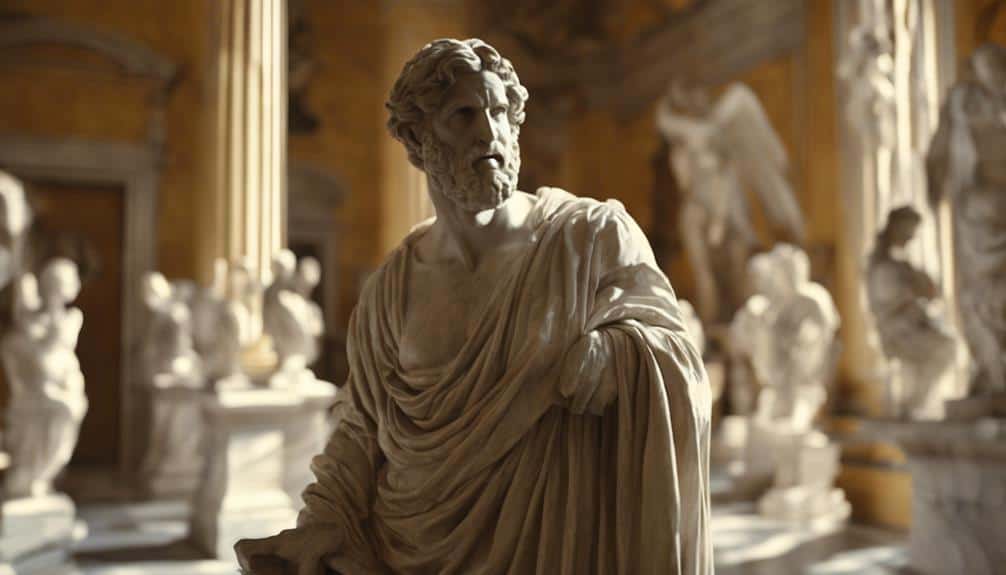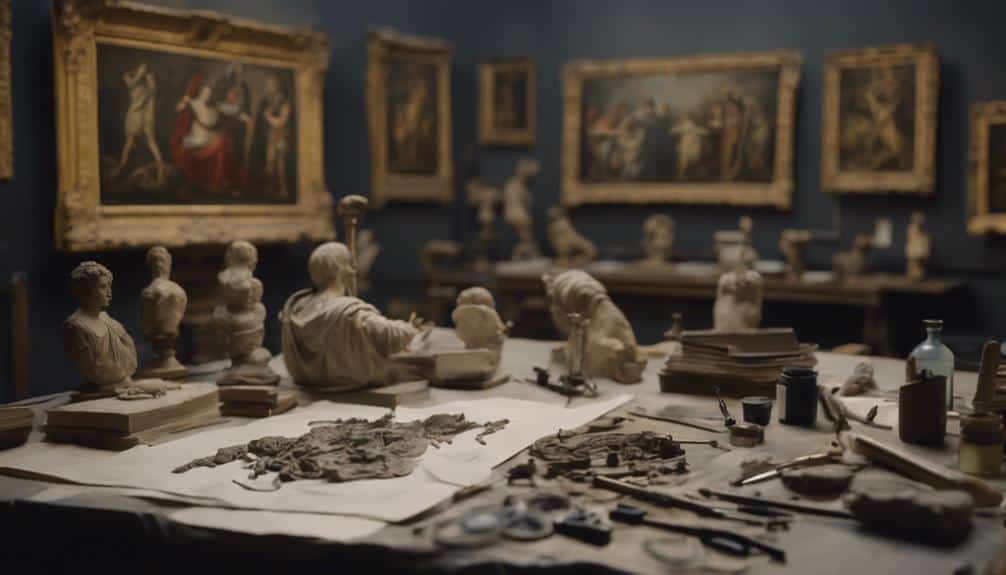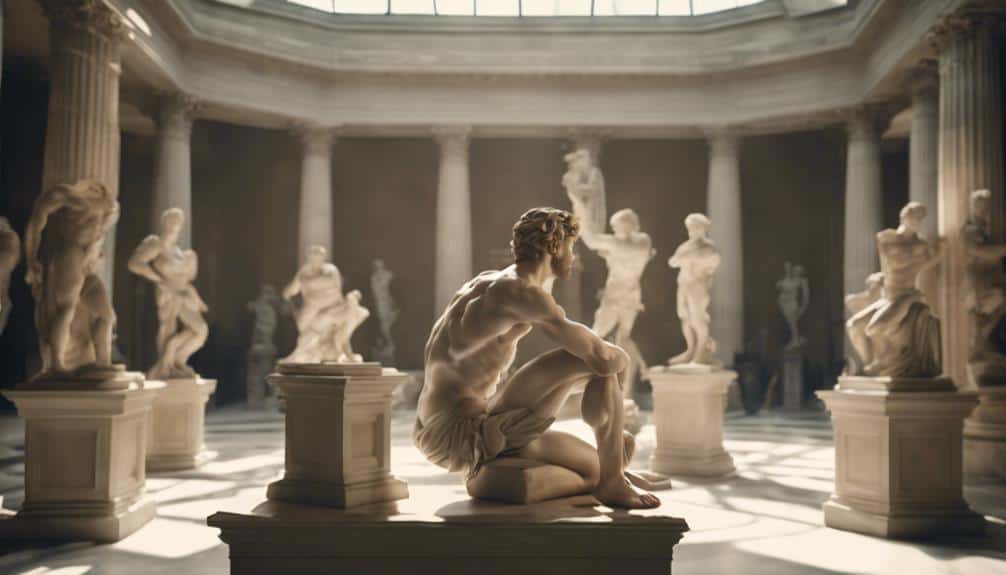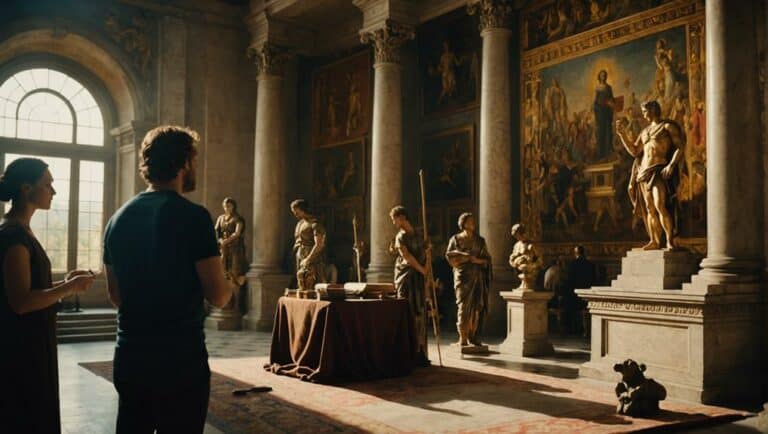Discover how Renaissance masters like Michelangelo and Raphael drew from ancient Greek and Roman sculptures to create art rich in realistic details and emotional depth.
Dive into the pivotal role of Pope Julius II's patronage and the challenges of preserving these masterpieces, as classical ideals fused with innovative techniques to reshape Western art.
Rediscovery of Ancient Sculptures
The rediscovery of ancient sculptures during the Renaissance reignited classical ideals in art, fundamentally transforming the artistic landscape of the period. Renaissance artists, deeply inspired by these ancient masterpieces, meticulously studied the classical art that had once flourished in Rome.
The unearthing of works like the Apollo Belvedere and the Laocoon provided tangible connections to the past, embodying ideals of beauty, proportion, and realism that artists sought to emulate. Michelangelo, a towering figure of the Renaissance, was particularly influenced by these ancient sculptures. He drew significant inspiration from the Belvedere Torso, a Roman copy of a Greek statue.
This piece, with its dynamic pose and powerful depiction of internal struggle, shaped Michelangelo's approach to capturing human form and movement. The realistic details and idealized forms of classical art found in these ancient works became benchmarks for Renaissance artists, who aimed to revive and surpass the artistry of antiquity.
Key Influences on Renaissance Artists

Examining the profound impact of ancient sculptures, one can identify several key influences that shaped the artistic vision of Renaissance masters. The Italian Renaissance saw artists like Leonardo da Vinci draw inspiration from ancient art, particularly Greek and Roman sculptures. These artists admired the realistic details and emotional expressions found in works such as the Apollo Belvedere and Laocoon, integrating these elements into their own creations.
The Belvedere Torso, a Roman copy of a Greek statue, profoundly influenced Michelangelo. Its depiction of internal struggle and dynamic pose informed his understanding of the human form, furthering his artistic development. This interplay between classical style and Renaissance innovation led to a unique blend of art forms.
Art patrons played a pivotal role in this cultural revival. For instance, Pope Julius II's establishment of the Belvedere Courtyard provided artists access to ancient sculptures, preserving and showcasing these masterpieces. This patronage was instrumental in the Renaissance's artistic achievements.
Direct influences from ancient artworks are evident in the mimicked poses, styles, and themes of Renaissance art. By studying these classical forms, Renaissance artists were able to revive and innovate, leaving an indelible mark on the course of art history.
Classical Ideals in Renaissance Art

In embracing classical ideals, Renaissance art seamlessly integrated realism, symmetry, and harmony, drawing deeply from the rich heritage of ancient Greek and Roman sculptures. You can see how artists like Michelangelo and Raphael skillfully revived these classical ideals. They didn't just mimic ancient art; they innovated, blending the old with the new to create something uniquely Renaissance.
The emphasis on the human form, an ideal from ancient times, can be seen vividly. Michelangelo's David, for instance, echoes the perfection and anatomical precision found in ancient sculptures.
Pope Julius II's patronage played a pivotal role in this artistic revival. Under his influence, Rome experienced a cultural renaissance, rediscovering and preserving ancient sculptures. These ancient masterpieces, such as the Apollo Belvedere and the Laocoon, directly influenced Renaissance art. Artists studied these works meticulously, allowing them to incorporate classical poses and styles into their own creations.
This revival wasn't just about aesthetics; it reflected a deeper philosophical alignment with classical ideals of balance and naturalism. By studying and emulating ancient art, Renaissance artists achieved a harmonious blend of classical ideals and contemporary innovation, culminating in a period of extraordinary artistic achievement.
Challenges in Restoration and Preservation

Managing the complexities of restoration and preservation, conservators face significant challenges in maintaining the authenticity of ancient artworks. The delicate balance between restoration and preservation is paramount, especially when considering the historical significance and integrity of these pieces.
In places like Rome and Pompeii, debates rage over the correct methodologies, highlighting the intricate nature of preservationism in modern times.
One striking example is the Laocoon statue, whose restoration history underscores the potential pitfalls. Early attempts often introduced errors, compromising its authenticity. These missteps serve as cautionary tales, illustrating the need for meticulous and informed approaches.
As a conservator, you must navigate these complexities, ensuring that every intervention respects the original craftsmanship and context of the artwork.
Preservationism advocates for cautious practices, emphasizing minimal intervention to prevent further degradation while maintaining historical integrity. However, balancing this with the necessity of restoration poses ongoing challenges.
You need a deep understanding of both the artwork's material composition and its cultural context. This knowledge allows you to make informed decisions, ensuring that the preservation efforts enhance rather than detract from the artwork's historical narrative.
The goal isn't merely to repair but to sustain the legacy of ancient artworks for future generations.
Michelangelo's Classical Inspirations

Michelangelo's deep commitment to ancient sculptures like the Apollo Belvedere and Laocoon greatly shaped his masterful portrayal of movement and emotion in Renaissance art. By studying these classical influences, Michelangelo imbued his own works with a profound sense of realism and dynamism.
The Apollo Belvedere, celebrated for its idealized human form, provided a template for Michelangelo's exploration of anatomical perfection. Similarly, the Laocoon, with its intense depiction of struggle and pain, informed his ability to convey raw, visceral emotion.
One can't overlook the significance of the Belvedere Torso, a Roman copy of a Greek statue, which deeply influenced Michelangelo. This sculpture's depiction of internal struggle and muscular tension resonated with him, guiding his artistic approach.
By integrating the lessons learned from these ancient works, Michelangelo's creations, such as David and the Sistine Chapel ceiling, exhibit a seamless blend of classical and Renaissance styles.
Michelangelo's access to these ancient sculptures wasn't merely about admiration; it was a rigorous study of their form and substance. His dedication to understanding the human form through classical influences allowed him to push the boundaries of Renaissance art, creating masterpieces that continue to captivate and inspire.
Legacy of Classical Revival in Art

The revival of classical ideals during the Renaissance profoundly transformed the trajectory of Western art, embedding ancient principles of symmetry, harmony, and realism into the core of artistic expression. This resurgence drew heavily from the artistic practices of Ancient Rome, where the emphasis on physical perfection and meticulous detail set a formidable standard. Renaissance art, under the influence of classical ideals, pursued these elements with vigor, fostering a new era of aesthetic excellence.
Michelangelo, a paramount figure of this period, epitomized the integration of these ancient principles. His works, profoundly shaped by the study of ancient sculptures like the Apollo Belvedere and the Belvedere Torso, exhibit an unparalleled mastery over movement and emotional expression. The rediscovery of such artifacts during Rome's cultural renaissance, bolstered by the patronage of Pope Julius II, provided artists with a tangible connection to the revered art of antiquity.
In adopting these classical ideals, Renaissance artists not only revived but also innovated upon their ancient predecessors' legacies. The emphasis on physical perfection and realism became a lasting hallmark, influencing artistic endeavors far beyond the Renaissance. The classical revival's impact continues to be a cornerstone in the evaluation and appreciation of Western art today.


